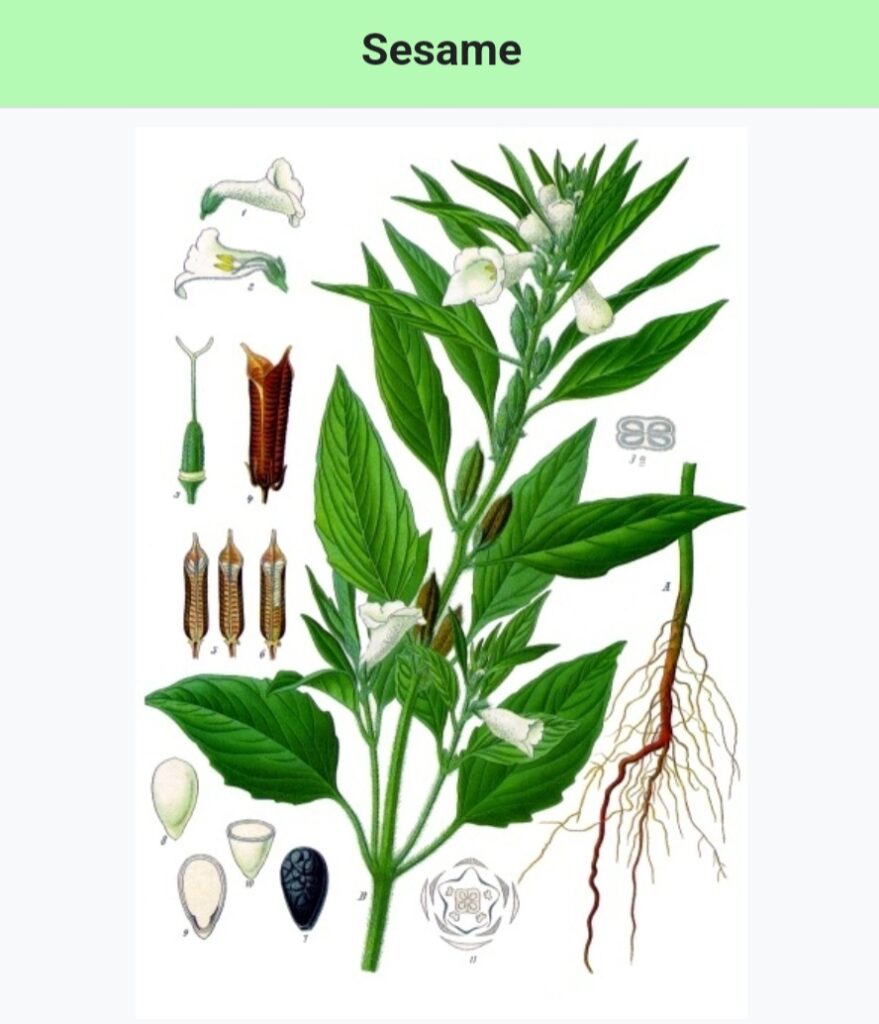
Sesame (Sesamum indicum), is a plant in the family Pedaliacea and genus Sesamum. It is also called several names like simsim, benne or gingelly. It is believed to have likely originated from Asia or East Africa. Today, sesame plant is found in most of the tropical, subtropical, and southern temperate areas of the world. Numerous wild relatives occur in Africa and a smaller number in India. It is widely naturalized in tropical regions around the world and is cultivated for its edible seeds, which grow in pods. The world largest producer of sesame include Sudan, Myanmar, and India. Sesame plant is an erect annual plant, grown for its seeds, which are used as food and flavouring and from which a prized oil is extracted. The aroma and taste of sesame seed are mild and nutlike. The chief constituent of the seed is its fixed oil, which usually amounts to about 44 to 60 percent. Noted for its stability, the oil resists oxidative rancidity. The seeds are also high in protein and are rich in thiamin and vitamin B6.
DESCRIPTION OF SESAME PLANT
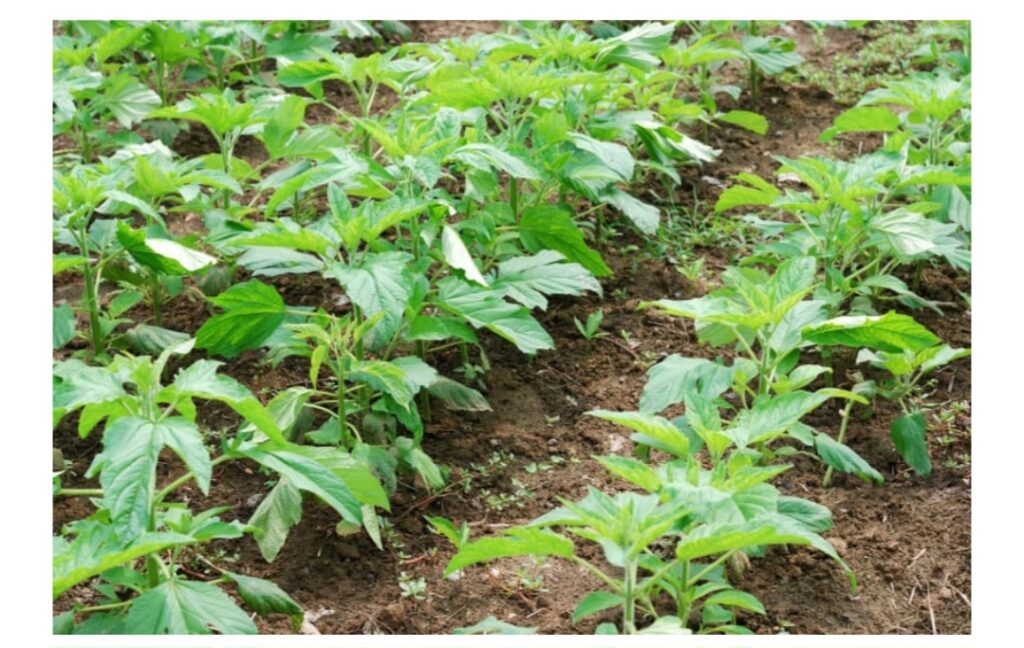
THE PLANT: Sesame plant (Sesamum indicum) is made up of different varieties which can grow from about 0.5 to 2.5 metres (2 to 9 feet) tall depending on environmental and climatic conditions. Some varieties have branches, others do not.
STEM: The stem is erect, green, and can be smooth, slightly hairy, or very hairy. It can be square in section with longitudinal furrows, or rectangular or flat.
LEAVES: The leaves can be 3–17.5 cm long and 1–7 cm wide. The lower leaves are broad and sometimes lobed, while the upper leaves are more narrow and lanceolate.
FLOWER: The flowers are tubular, bell-shaped, and can be light purple, rose, or white in colour. They grow in the leaf axils and bloom from late summer to early autumn. One to three flowers appear in the leaf axils when developing.
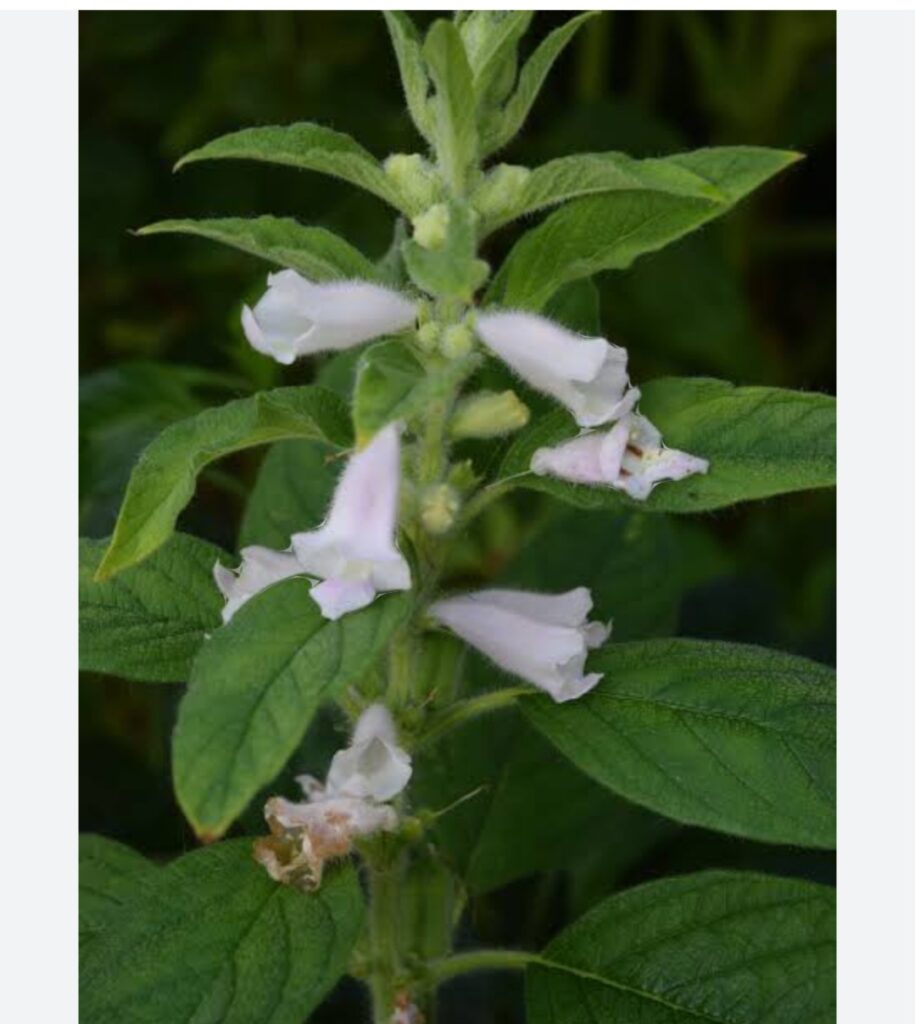
FRUIT: The fruit is a rectangular capsule that contains the seeds. The capsules are 2–3 cm long and 6–12 mm in diameter.
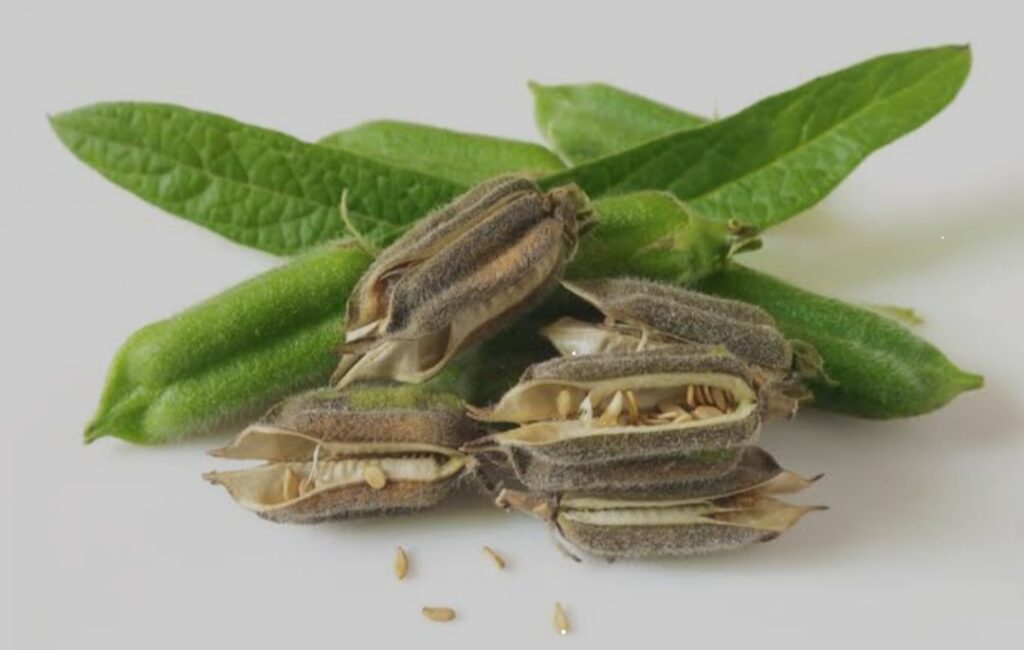
SEEDS: The hulled seeds are creamy or pearly white, black, yellow, or brown and about 3 mm (0.1 inch) long and have a flattened pear shape. They are rough with wings at either end. The seeds are produced in a capsule. The seed capsules open when dry, allowing the seed to scatter. Hand labour is employed in harvesting to prevent loss of the seeds. With the development of a nonscattering variety of the plant in the mid-20th century, mechanized harvesting of the crop was made possible.
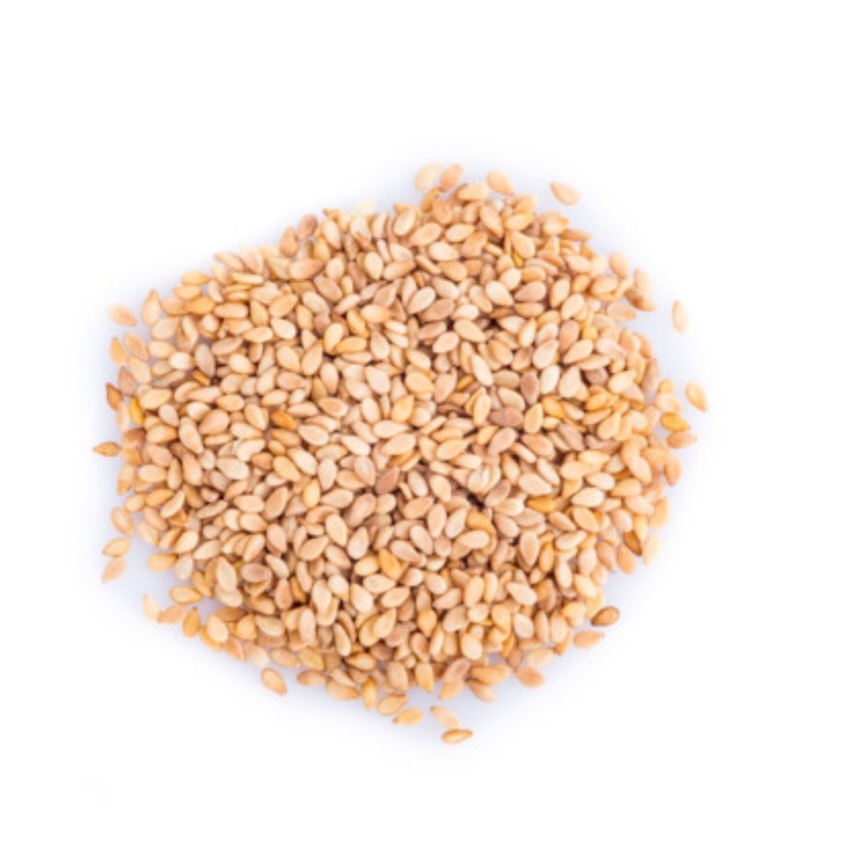
ROOTS STEM : The sesame plant has a well-developed root system with profuse lateral branches. This makes the plant very tolerant of drought.
USES OF SESAME
Sesame seed is the main beneficial part of the plant. This gives reason why sesame is cultivated all over the world.
1. The ancient Egyptians are known to have used the ground seed as grain flour.
2. Chinese At about 5,000 years ago till date, extract oil from the seeds and burned the oil to make soot for the finest Chinese ink blocks.
3. In the past, the Romans ground sesame seeds with cumin to make a pasty spread for bread.
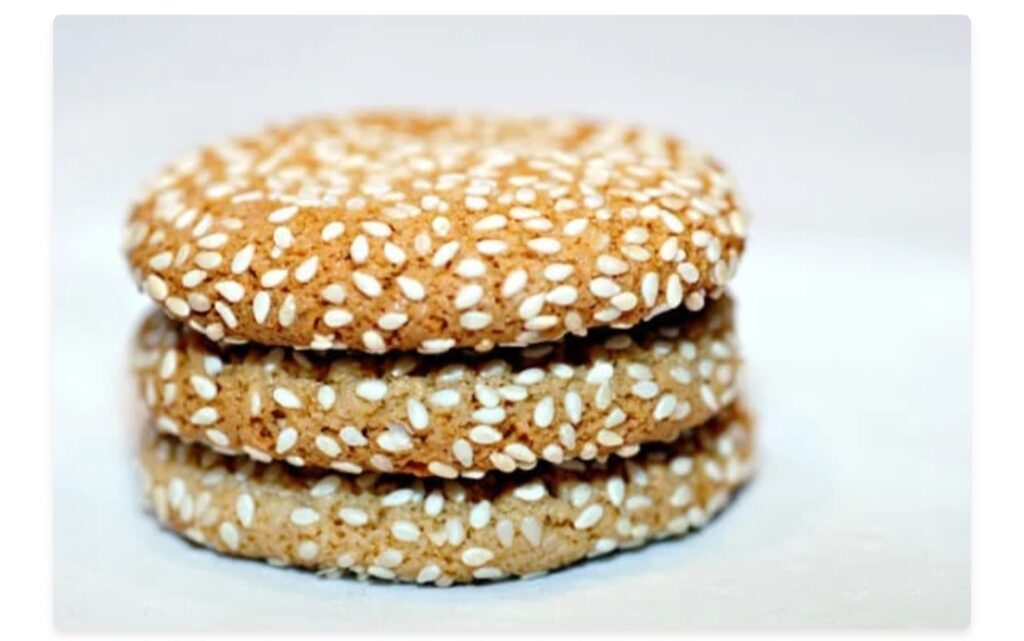
4. The sesame plant was once thought to have mystical powers, and sesame still retains a magical quality, as shown in the expression “open sesame,” from the Arabian Nights tale of “Ali Baba and the Forty Thieves.”
5. Sesame oil is used as a salad oil or cooking oil, in shortening and margarine,
6. The oil is used in the manufacture of soaps, pharmaceuticals, and lubricants.
7. Sesame oil is used as an ingredient in cosmetics.
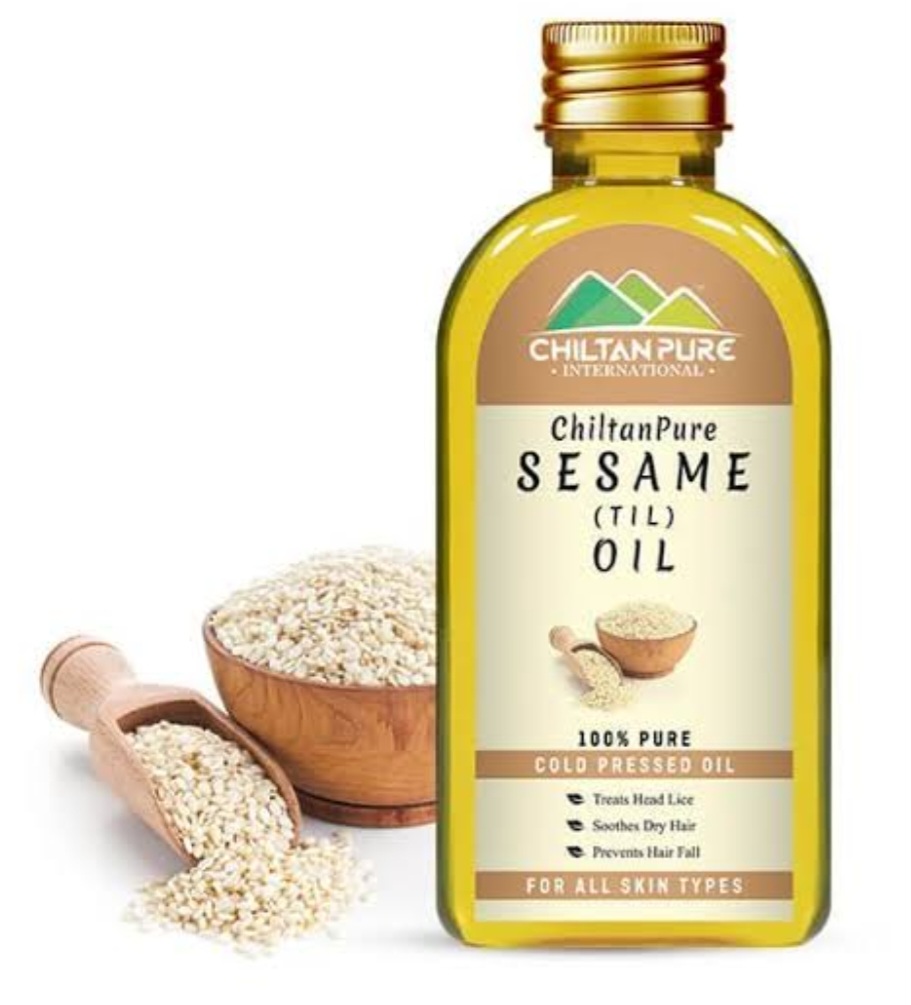
8. The press cake remaining after the oil is expressed is highly nutritious.
9. The whole seed is used extensively in the cuisines of the Middle East and Asia.
10. Halvah is a confection made of crushed and sweetened sesame seeds.
11. In Europe and North America the seeds are used to flavour and garnish various foods, particularly breads and other baked goods.
12. Tahini, paste of crushed sesame seeds is widely used in Middle East for cooking.
13. Tahini mixed with garlic, lemon juice, and salt and thinned with water constitutes taratoor, a sauce that is eaten as a dip with Arab bread as part of a selection of meze, or hors d’oeuvres.
14. Taratoor is mixed with ground chickpeas for hummus bi tahini, another hors d’oeuvre dip.
15 .Tahini is also used as a sauce ingredient for fish and vegetable dishes.
16. Sesame seeds are rich in protein, vitamins, minerals, and antioxidants.
17. Sesame seeds contain lignans and phytosterols, which are plant compounds that can help lower cholesterol in the body. Phytosterols are also believed to enhance immune response and decrease risk of certain cancers.
18. Sesame seed also contain substances called sesamin and sesamolin. These two substances have antioxidant and antibacterial properties. Antioxidants are important to health because it protect the body against various diseases by slowing down damage to cells.
The antibacterial activity of sesame seeds is proven to fight against staph infections and strep throat as well as common skin fungi, such as athlete’s foot.
19. Type 2 diabetes is a lifelong disease that does not allow the human body to produce insulin the way it should. This result in high blood sugar level called hyperglycemia. Research had shown that taking oil of sesame seeds with type 2 diabetes medications enhances the effectiveness of the treatment.. Eating healthy foods like sesame seeds can help people with type 2 diabetes reach their target blood sugar levels. Additionally, the antioxidants in sesame oil reduce the amount of sugar in the blood.
20. A lot of people believed to have poor oral hygiene Sesame seeds can also get rid of the bacteria that cause plaque on your teeth. An ancient practice called oil pulling is shown to improve your oral hygiene and health when practiced regularly and correctly. Sesame oil is one of the most common oils used in this practice, which involves swishing a tablespoon of oil around your mouth when you wake up in the morning.
CLIMATIC REQUIREMENT
Sesame is a drought resistant plant that thrives in warm climate and it is primarily grown for its oily seeds. the oil is used in cooking, cosmetics etc.
It grows best in areas with mean annual rainfall of 300-600mm and temperature between 25-30°C. If the temperature is more than 40°C with hot wind, the oil content will reduce. If the temperature goes beyond 45°C or below 15°C, yield will decrease.
SOIL REQUIREMENT: Sesame plants can grow best in well-drained, fertile, medium-textured soils. They thrive in sandy loam soils. They are intolerant of acidic or saline soils and cannot tolerate wet conditions. They require soil with pH range of 5.5 to 8.0.
LAND PREPARATION: Sesame plants need a fine, firm, and smooth seedbed. To achieve this, clear the land of weeds, rocks and other debris. Plough the soil to break up clods. Harrow and create a fine seed beds. It is recommended to do land Preparation one month before planting or sowing.
SEEDS SELECTION: Select high quality seeds for planting. Choose seeds that are uniform in size, shape and free from pests and diseases and have a high yield germination rate.
SOWING: Sow seeds directly in the field preferably during the onset of monsoon. Seeds should be sown at the depth of 2-3cm between rows and 10cm between plants.
To facilitate seeding and achieve even distribution, the seeds can be mixed with dry sand or well sieves farm yard manure in the ratio 1: 20. Seed drill can be done to sow seeds into the soil. The depth of drills should not be deeper than 2.5cm. Placement method can then be used to sow the seed. Deep seeding can affect germination and plant stand.
SPACING: Spacing depends on sesame variety, plant type and season. Some varieties are planted 30cm ×15cm. Some 60cm×15cm, while some have spacing of 45cm ×15cm.
SEED TREATMENT: Sesame seeds should be treated before sowing to prevent seed borne diseases. They should be treated with fungicides or bactericides.
IRRIGATION: Sesame is a drought resistant plant and can tolerate low rainfall. however, regular irrigation is necessary during the early growth stage. Avoid waterlogging as it may cause root rot.
FERTILIZER APPLICATION: apply 20-25kgN, 40-50kgP per hectare of land during land Preparation. Apply 20-25kgN per hectare of land as a top dressing after 30 days of sowing.
WEEDING; this is critical in sesame farming as weeds compete with the crop for sunlight, nutrients and water. use pre-emergence herbicide and hand weeding to control weeds.
PEST AND DISEASE CONTROL
Sesame is susceptible to pest and diseases such as stem borers, aphids, whiteflies and fusarium wilt etc.
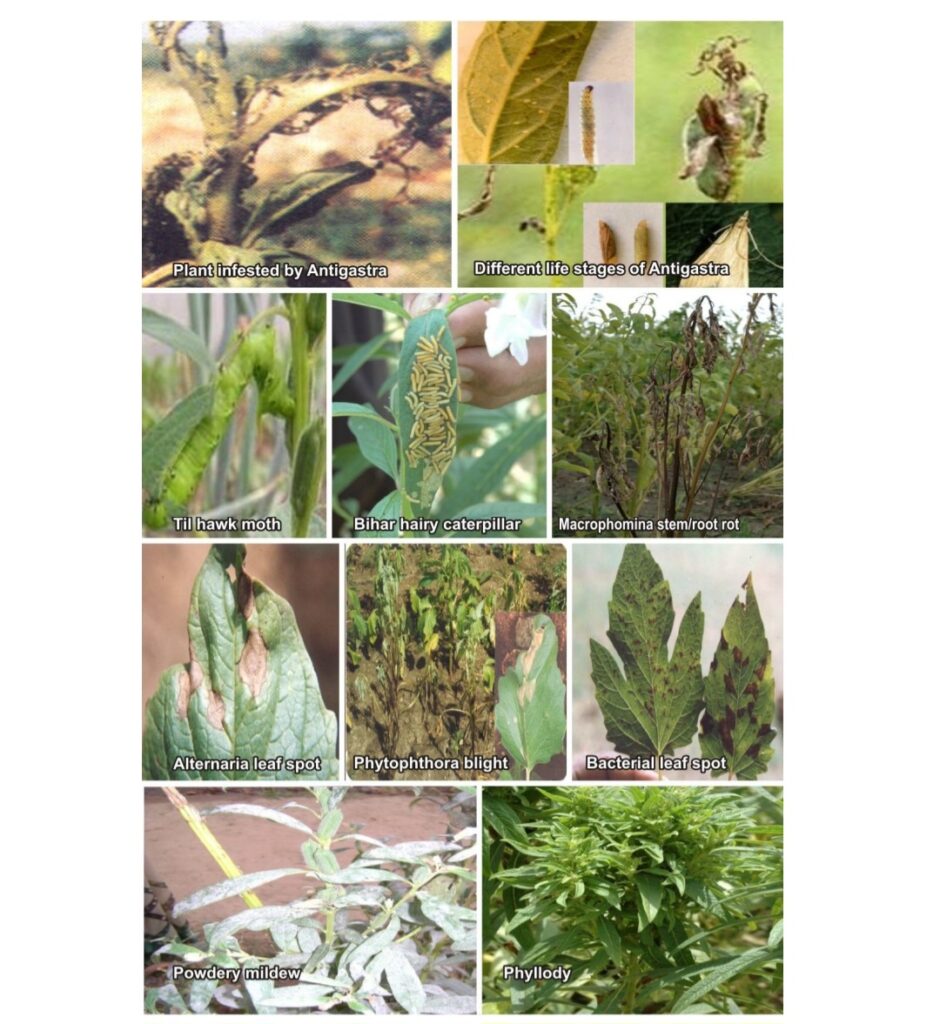
PESTS
1. LEAF ROLLER OR WEBBER AND CAPSULE BORER ( Antigastra catalaunalis): This pest is most prevalent during the capsule formation and early vegetative stages of the plant. They start attacking the plant at 2-3 weeks after germination when the leaves are still tender. The damage is easy to identify, as it’s often marked by small black balls of excrement. The caterpillars feed on the tender leaves. The larvae feed inside the plant, boring holes into the pods and destroying the seeds.
CONTROL: Early sowing of seeds, intercropping, crop rotation, use of biological control by allowing birds to feed on the pests, spraying insecticides etc.
2. LEAF HOPPER ( Orosius albicinctus)
The nymph stage and adult stage sucks the sap of tender parts of the plants. This pest causes the leaves to curl at the edges, turn red or brown, dry up, and shed.
CONTROL: Remove infested parts and destroy, seed treatment, intercropping and spray insecticides.
3. GALL FLY ( Asphondylia sesami).
The fly lay eggs that hatch to produce maggots.
The maggots of this pest cause buds to develop into galls that produce no fruits or seeds.
CONTROL: Gall clipping, picking and burning the shed buds, plant resistant varieties and spray insecticides.
Other pests include:
4. TIL HAWK-MOTH ( Acherontia styx): This pest is made up of large caterpillars that feed on leaves and defoliate the plants.
CONTROL: Deep ploughing, collect and destroy caterpillars and spray insecticides.
5. WHITEFLY: This pest sucks the cell-sap from the lower surface of leaves and also in the tender leaves.
6. TIL LEAF AND POD CATERPILLAR : This pest feeds on leaves and bores into shoots, flowers, buds, and pods, damaging young plants.
7. MIRID BUG: This pest sucks the cell-sap from tender leaves, flowers, and fruits.
8. APHIDS: This pest causes stunted growth and may injure buds, preventing the development of seedpods.
9. THRIPS: This pest causes stunted growth and may injure buds, preventing the development of seedpods.
Some ways to manage these pests include:
1. Insecticidal soap spray: This can be used to manage aphids, leafhoppers, and thrips.
2. Neem oil: This can be used to smother pests.
3. Bt (Bacillus thuringiensis): This naturally occurring bacteria can be used to treat leafrollers, cutworms, and other caterpillars.
4. Also, use pesticides and fungicides to control pests and diseases
DISEASES
Some common diseases of sesame include:
1. PHYLLODY: A phytoplasma disease transmitted by leafhoppers. It causes abundant abnormal branching of the shoot which causes the top of the shoot to bend. Also, infected plants do not bear capsules. But peradventure capsules are produced, the seeds will be of low quality.
PREVENTION AND TREATMENT: Intercropping, delay in planting, spray insecticides to kill leaf hoppers, Rogueing, spray neem oil etc.
2. MACROPHOMINA ROOT AND STEM ROT: A destructive disease caused by the fungus Macrophomina phaseolina. The diseases appear on root and stem. The plant will show symptoms of wilting, at ground level, the stem becomes black in colour which extend upward rupturing the stem. If wilted plants are uprooted, black coloured roots will be observed showing signs of sclerotia of the fungi.
PREVENTION AND TREATMENT: Crop rotation, deep ploughing, soil drenching, plant resistant varieties etc.
3. CERCOSPORA LEAF SPOT (CLS): A fungal disease caused by the fungus Cercospora sesami. The disease appear as small angular brown leaf spot of about 3mm in diameter with grey center and brown margine. Under severe condition, defoliation occurs. Lesion may also occur
PREVENTION AND TREATMENT: Early planting, intercropping, plant resistant varieties and spray chemicals.
4. POWDERY MILDEW: A fungal disease caused by the fungus Erysiphae cichoracearum . Small cottony spot appear on the affected leaves which spread to the laminar. Under severe condition, defoliation occurs.
PREVENTION AND TREATMENT: Early planting, intercropping, plant resistant varieties, and spray chemicals on the leaves.
5. BACTERIAL LEAF SPOT AND BLIGHT: A bacterial disease caused by Pseudomonas syringae pv. sesami. Plant shows symptoms of small angular,light brown to brown spot confines on veins with dark margins. When disease spread to veins and petioles, defoliation occurs.
PREVENTION AND TREATMENT: Seed treatment with hot water and foliar spray with chemicals.
6. PHYTOPHTHORA BLIGHT: A fungal disease . It shows signs of initial water soaked spots on the leaves and stems. In the beginning, the spot turn brownish and later turn to black colour.
PREVENTION AND TREATMENT: Deep ploughing, improve drainage system, crop rotation, plant diseased free seeds, seed treatment, spray chemicals.
HARVESTING: One of the signs for harvesting is the leaves turn yellowish and start to droop. sesame is ready for harvesting when the capsules turn brown and start to split open. Harvest by cutting the crop at the ground level and allow them to dry for few days. Thresh the dried plants by beating with stick or machine thresher and separate the seeds from the capsules.

STORAGE: Store sesame seeds in a cool dry place to prevent spoilage. use appropriate storage containers to prevent pest infestation.
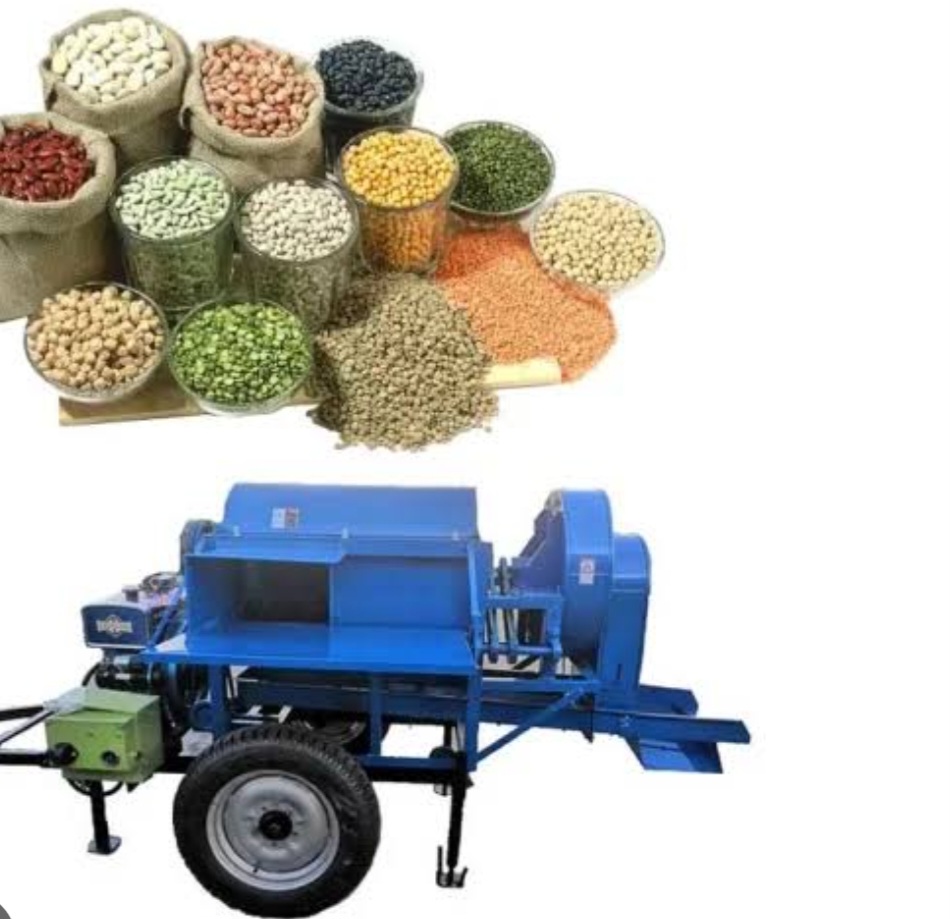
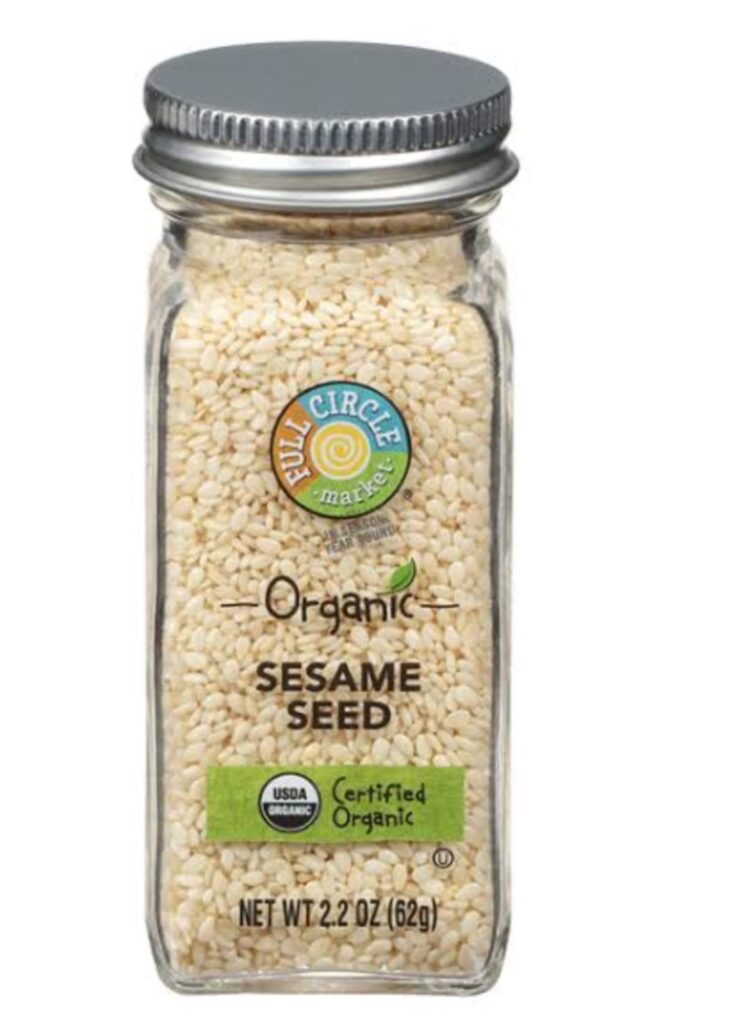
In conclusion, sesame farming require proper planning, implementation and execution of the plan to earn a profitable income from its cultivation. Careful following of the above steps of its cultivation will bring about a bountiful harvest and increase farmers income.
